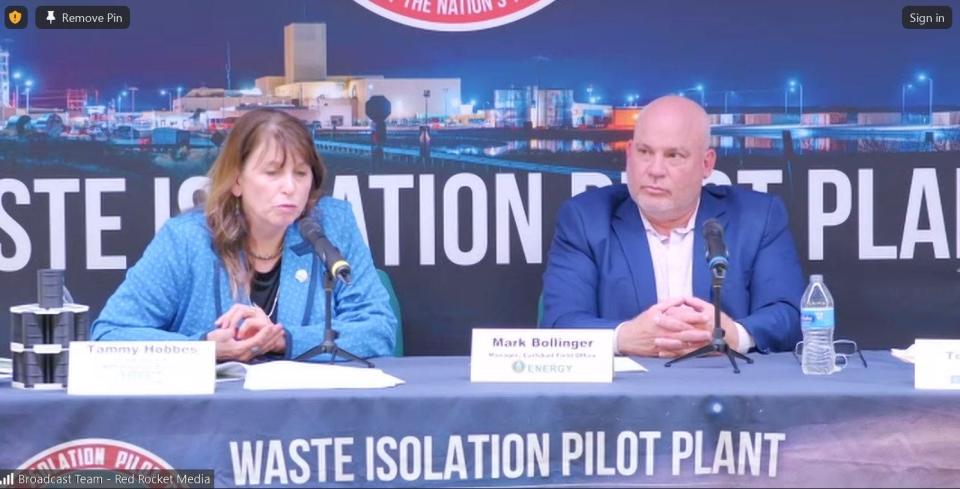Nuclear waste site near Carlsbad to double in size, take waste until 2083, officials say
Nuclear waste could continue to be disposed of in southeast New Mexico for another 60 years, officials said.
Mark Bollinger, manager of the U.S. Department of Energy’s Carlsbad Field Office said Tuesday the Waste Isolation Pilot Plant could remain operational until 2083, based on the facility’s capacity and the availability of waste for disposal.
WIPP is owned by the DOE and is used to bury transuranic (TRU) nuclear waste made up of clothing materials, equipment and debris irradiated during nuclear research and development at government facilities across the country. The waste is shipped to WIPP, about 30 miles east of Carlsbad, and buried in an underground salt formation.
More: 'State consent' on nuclear stripped from Senate bill
Those operations were initially projected to cease in 2024 since beginning in 1999, meaning the facility was expected to dispose of TRU waste for 25 years. But Bollinger, during a public forum hosted in Roswell, said WIPP will likely continue its disposal for “several decades to come.”
The 2083 end date was previously expressed by Bollinger’s predecessors but was recently formalized via a planned change request (PCR) document submitted March 14 to the Environmental Protection Agency. That PCR’s approval was needed for WIPP to use two new panels mined in the underground to hold more waste.
“Our current capacity shows we will be able to handle waste for several decades to come,” Bollinger said during the meeting. “We want to make the most of the investment.”
More: Holtec's New Mexico nuclear waste proposal questioned during federal court hearing
The PCR justified adding space as replacement capacity lost in 2014 when a waste drum already emplaced ruptured, contaminating the air and leading to a three-year shutdown of WIPP’s waste handling operations.
When WIPP reaches the assumed 2083 closure date, the site was expected to have 19 panels total, meaning seven more will be added in addition to the two replacement panels read the document submitted by the DOE to the EPA, to meet the facility’s statutory capacity of 6.2 million cubic feet of waste.

Panels 13 through 19 will need additional federal approval and were likely to be located on the west end of the mine alongside the replacement panels, records show.
More: Renewable energy at nuclear waste site near Carlsbad? Here's how you can comment
Bollinger said WIPP was at about 43 percent capacity, with 2.6 million cubic feet of waste disposed of so far.
Tammy Hobbes, national TRU program manager at Salado Isolation Mining Contractors (SIMCO) – the DOE hired contractor to conduct WIPP’s operations – said mining was underway on the west side of the mine. The work will create drifts to connect that area with new utility shaft being built and additional disposal panels.
“We are doing some mining of the west mains and getting ready to expand on the west side of our mine,” she said. “We don’t want to finish a new panel too soon. As soon as we start mining, the salt starts moving so we are very strategic about when we are mining and when we start mining in a new room.
More: Aging infrastructure could pose risks at Waste Isolation Pilot Plant nuclear waste site
But the notion of expanding WIPP and keeping it open longer drew concerns from those in attendance at the meeting including Cynthia Weehler, a resident of Santa Fe area and member of the 285 Alliance, a group that frequently raises criticisms of the WIPP project and the risks posed.
Weehler said her home and many others in the area are along U.S. Highway 285, a main thoroughfare connecting northern New Mexico with the southeast region and used by drivers to bring waste to WIPP.
The longer waste is shipped this way to WIPP she said, the more risk it brings to locals.
More: US Senate OKs funding bill for New Mexicans impacted by Trinity Site
“If you’re talking about extending the lifetime of the facility, shipping more waste and more kinds of waste, you’re putting us at more risk,” Weehler said. “As someone who lives in an at-risk community along the transportation routes, I cannot accept several decades to come.”
Hobbes countered that a longer time frame was necessary to maintain safety in WIPP operations. She said additional procedures were added after the 2014 event to prevent future incidents, meaning waste was shipped at a slower rate than before.
“I think the procedures were drastically changed from that event,” Hobbes said. “I don’t like to say it slowed things down, but it does make things take a little longer.”
More: It's been a decade since the radiological release at WIPP. Here's what has happened since then.
Don Hancock, nuclear waste program director at the Southwest Research and Information Center in Albuquerque questioned the DOE’s transparency in an expansion of WIPP he said appeared indefinite.
He said a public analysis should be conducted of WIPP and its plans to stay open for at least six more decades.
“People need to understand that that is kind of thing that is going on. Now you’re saying that rather than 25 or 35 years, you’re saying 85 years,” Hancock said. “That’s a significant change. I hope you understand why people say that is forever WIPP. There is no actual end date.”
Adrian Hedden can be reached at 575-628-5516, achedden@currentargus.com or @AdrianHedden on the social media platform X.
This article originally appeared on Carlsbad Current-Argus: WIPP to receive waste until 2083, officials say of site near Carlsbad

